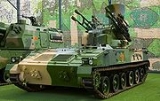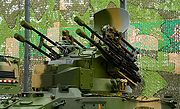
Type 95 SPAAA
Encyclopedia
The Type 95 is a Chinese
self-propelled anti-aircraft vehicle. It is armed with four 25 millimeter cannons and optionally four fire-and-forget
QW-2 infra-red homing missiles. It was first displayed publicly at the Beijing Military Parade in 1999. Earlier in development the system was designated Type 90-II and Type 90-III.
Mounted on the front of the turret in an armoured box is the electro-optical tracking equipment which consists of a TV tracking camera, and infra-red tracking camera and a laser rangefinder. The tracking cameras have a day range of approximately 6,000 meters and a night range of 5,000 meters. The laser rangefinder has a range of between 500 and 5,500 meters with an accuracy of 5 meters. Mounted on either side of the turret are two 25 millimeter Type 87 cannons, which eject spent shell casings to either side of the vehicle. The 25mm cannons have a rate of fire of 600-800 rpm each,and are gas-operated. About 1,000 rounds are carried. The cannons are used to engage targets out to a range of 2,500 meters and at altitudes of up to 2,000 meters. Additionally two QW-2 infra-red homing missiles can be mounted above the cannons on each side. The QW-2 missiles are based on a shoulder launched missile and can engage targets flying between 10 and 3,500 meters in altitude at a slant range of between 500 and 6,000 meters. To the rear of the turret is the CLC-1 S-band pulse-doppler search radar which has a reported range of 11 kilometers, and is optimized to detect low-flying targets. Finally, an array of four electrically fired smoke grenades are mounted on either side of the turret, aimed to fire forward and to either side of the vehicle.
 A large door which opens to the left is provided in the rear of the hull.
A large door which opens to the left is provided in the rear of the hull.
The system can automatically optically track targets and provide the gunner with an alert when the target is within range. The gunner can also manually aim the guns, using either the optical system or an external backup ring sight provided on the outside of the turret. The system has a reaction time of around 10 seconds when in radar search mode, and six seconds in optical mode. The vehicle also provides a simulator function for training.
A battery control vehicle using the same chassis is also built. It has a crew of five people. It uses a S-band CLC-2 surveillance radar with a maximum range of 45 kilometers and a maximum altitude of 4,500 meters. The communication system in the vehicle allows it to communicate digitally to a range of up to 5 kilometers and via a normal radio link up to 15 kilometers. Additionally it can use signal wire to communicate up to 500 meters. An Auxiliary Power Unit (APU) provides power for the electronics. A single 12.7 mm heavy machine gun is provided for self-defense.
A typical Type 95 battery consists of six SPAAA vehicles, and a single command vehicle. Additionally, be three ammunition re-supply trucks, a test/repair truck and a power supply truck support each battery.
China
Chinese civilization may refer to:* China for more general discussion of the country.* Chinese culture* Greater China, the transnational community of ethnic Chinese.* History of China* Sinosphere, the area historically affected by Chinese culture...
self-propelled anti-aircraft vehicle. It is armed with four 25 millimeter cannons and optionally four fire-and-forget
Fire-and-forget
Fire-and-forget is a third-generation method of missile guidance. The military uses the term for a type of missile which does not require further guidance after launch such as illumination of the target or wire guidance , and can hit its target without the launcher being in line-of-sight of the...
QW-2 infra-red homing missiles. It was first displayed publicly at the Beijing Military Parade in 1999. Earlier in development the system was designated Type 90-II and Type 90-III.
Description
The vehicle uses a tracked armoured chassis with six road wheels, a drive sprocket, an idler and three return rollers on each side. The vehicle has a crew of three: driver, commander, and gunner. The engine is located at the front of the vehicle, with the driver sitting on the left side. The driver is provided with a hatch and three vision blocks for visibility when buttoned up. Behind the driver sits the commander, who is provided with a raised hatch, also fitted with three vision blocks. Towards the rear of the hull is the large powered one-man turret.Mounted on the front of the turret in an armoured box is the electro-optical tracking equipment which consists of a TV tracking camera, and infra-red tracking camera and a laser rangefinder. The tracking cameras have a day range of approximately 6,000 meters and a night range of 5,000 meters. The laser rangefinder has a range of between 500 and 5,500 meters with an accuracy of 5 meters. Mounted on either side of the turret are two 25 millimeter Type 87 cannons, which eject spent shell casings to either side of the vehicle. The 25mm cannons have a rate of fire of 600-800 rpm each,and are gas-operated. About 1,000 rounds are carried. The cannons are used to engage targets out to a range of 2,500 meters and at altitudes of up to 2,000 meters. Additionally two QW-2 infra-red homing missiles can be mounted above the cannons on each side. The QW-2 missiles are based on a shoulder launched missile and can engage targets flying between 10 and 3,500 meters in altitude at a slant range of between 500 and 6,000 meters. To the rear of the turret is the CLC-1 S-band pulse-doppler search radar which has a reported range of 11 kilometers, and is optimized to detect low-flying targets. Finally, an array of four electrically fired smoke grenades are mounted on either side of the turret, aimed to fire forward and to either side of the vehicle.

The system can automatically optically track targets and provide the gunner with an alert when the target is within range. The gunner can also manually aim the guns, using either the optical system or an external backup ring sight provided on the outside of the turret. The system has a reaction time of around 10 seconds when in radar search mode, and six seconds in optical mode. The vehicle also provides a simulator function for training.
A battery control vehicle using the same chassis is also built. It has a crew of five people. It uses a S-band CLC-2 surveillance radar with a maximum range of 45 kilometers and a maximum altitude of 4,500 meters. The communication system in the vehicle allows it to communicate digitally to a range of up to 5 kilometers and via a normal radio link up to 15 kilometers. Additionally it can use signal wire to communicate up to 500 meters. An Auxiliary Power Unit (APU) provides power for the electronics. A single 12.7 mm heavy machine gun is provided for self-defense.
A typical Type 95 battery consists of six SPAAA vehicles, and a single command vehicle. Additionally, be three ammunition re-supply trucks, a test/repair truck and a power supply truck support each battery.
Comparable Systems
- Tunguska-M1Tunguska-M1The 2K22 Tunguska is a Russian tracked self-propelled anti-aircraft weapon armed with a surface-to-air gun and missile system. It is designed to provide day and night protection for infantry and tank regiments against low-flying aircraft, helicopters, and cruise missiles in all weather conditions...
- ZSU-23-4ZSU-23-4The ZSU-23-4 "Shilka" is a lightly armored, self-propelled, radar guided anti-aircraft weapon system . ZSU stands for Zenitnaya Samokhodnaya Ustanovka , meaning "anti-aircraft self-propelled mount". The "23" signifies the bore diameter in millimeters. The "4" signifies the number of gun barrels. It...
- Flugabwehrkanonenpanzer GepardFlugabwehrkanonenpanzer GepardThe Flugabwehrkanonenpanzer Gepard is an autonomous, all-weather-capable German self-propelled anti-aircraft gun . It was developed in the 1960s and fielded in the 1970s, and has been upgraded several times with the latest electronics...
- Type 87 Self-Propelled Anti-Aircraft GunType 87 Self-Propelled Anti-Aircraft GunThe is a Japanese air defense weapon built around the Oerlikon 35 mm twin cannon system used on the Gepard tank. The system uses a modified Type 74 tank chassis...

